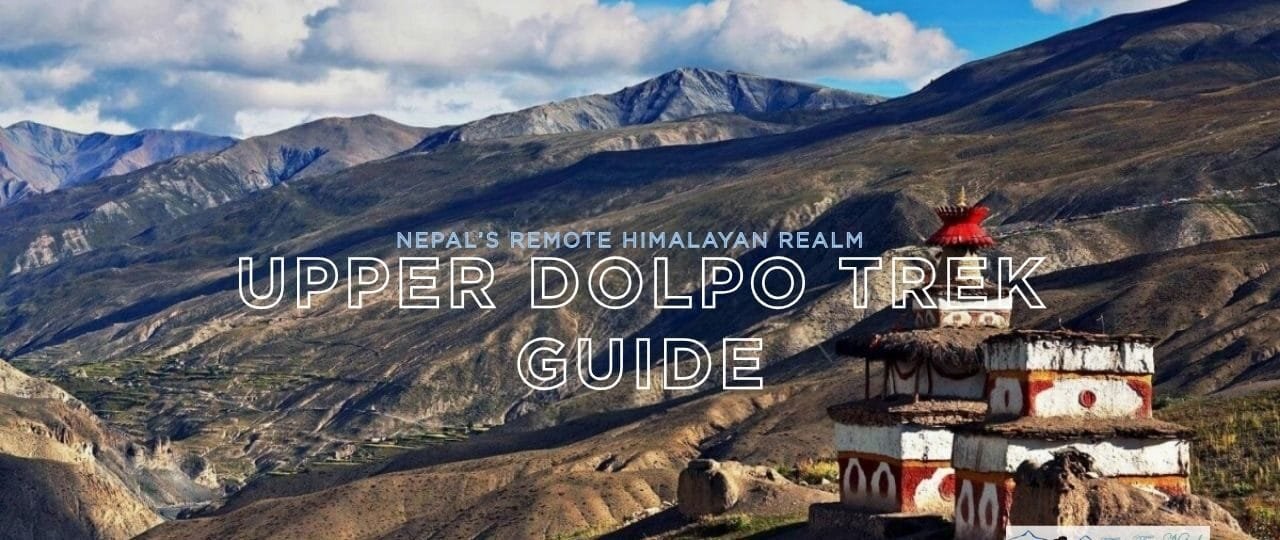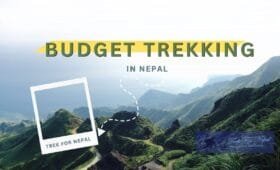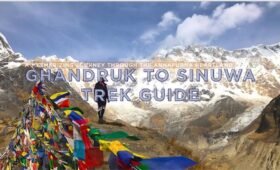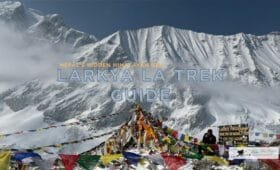The Upper Dolpo Trek is an odyssey into one of Nepal’s most secluded landscapes. It is renowned for its desolate highland deserts, centuries-old Tibetan-influenced culture, and hidden valleys perched at breathtaking altitudes. While less frequented than Everest or Annapurna Circuits, Upper Dolpo Trek opens doors to a realm of Himalayan wilderness, culminating in 5,000-meter passes that tower over turquoise lakes and austere monasteries. For those yearning for an offbeat expedition, venturing beyond typical tourist trails, the Upper Dolpo Trek might be the pinnacle of Himalayan adventure.
This extensive Upper Dolpo Trek guide delves into every dimension of the Trek—from the classic Upper Dolpo Trek Itinerary and cost breakdown to route highlights, difficulty levels, and best time to go. You’ll also discover how to blend your trek with philanthropic endeavors through Volunteers Initiative Nepal (ViN). Whether you’re a daring trekker keen on experiencing seldom-visited high passes or a cultural enthusiast seeking a more profound link to Tibetan Buddhism, the Upper Dolpo Trek promises an unmatched tapestry of solitude, dramatic scenery, and time-honored traditions.
Introduction
1. Introduction: Why the Upper Dolpo Trek?
The Upper Dolpo Trek is a sacred grail for those who crave majestic emptiness, secret gompas, and yaks trudging through formidable mountain passes. Historically, Dolpo was sealed from the outside world, preserving its archaic Tibetan-style living. Even now, sparse teahouses and limited road links maintain the region’s pristine aura. You can expect stark, high-altitude deserts reminiscent of the Tibetan Plateau, dotted with hidden villages that revolve around yak herding, barley cultivation, and unwavering Buddhist devotion.
Statistic: According to Nepal’s Department of Tourism, fewer than 2,000 foreign adventurers traverse Upper Dolpo annually. Compare that to the tens of thousands who swarm the Everest or Annapurna areas. This exclusivity solidifies Upper Dolpo Trek as a niche, exhilarating route for those who relish raw Himalayan wilderness with minimal crowds.
“The Upper Dolpo Trek changed my perspective on Nepal. The sheer quiet, the Tibetan dialect spoken by villagers, and the turquoise lakes nestled under 6,000-meter summits—it felt like stepping into another era,”
recounts James, a 33-year-old trekker from the UK who completed the journey last autumn.
History
2. Cultural & Historical Context
Dolpo (or “Dol-pa”) historically functioned as a trade corridor linking Tibetan salt routes with lower Nepal, enabling the exchange of salt, wool, and daily goods. The region’s inhabitants, often called Dolpo-pa, uphold Tibetan Buddhist or Bon traditions, with centuries-old monasteries perched on high ridges or inside hidden enclaves. Upper Dolpo Trek typically includes a pilgrimage-like experience for those visiting revered sites like Shey Gompa, rumored to be around 800 years old.
While Lower Dolpo is known for the glimmering Shey Phoksundo Lake, Upper Dolpo demands advanced permits and organizational acumen, rewarding trekkers with prolonged immersion in an unspoiled cultural sphere. Tibetan dialects, polyandry, and intricate shortens reflect how the region’s spiritual ethos merges with daily survival amid arid, high-altitude terrains. Government measures also preserve Dolpo’s heritage and biodiversity, designating certain sections as restricted areas with mandatory guides.
Trek Itinerary
3. Key Highlights of Upper Dolpo Trek Itinerary
While permutations exist, a traditional Upper Dolpo Trek Itinerary generally extends ~18–25 days. Some shorter versions skip certain side loops or pass expansions. Below is an exemplary outline ( ~21 days ):
Day 1: Kathmandu → Nepalgunj (~150m)
A ~1-hour domestic flight from Kathmandu. Overnight in Nepalgunj to catch the next day’s flight to Juphal.
Day 2: Flight Nepalgunj → Juphal (~2,475m), Trek to Dunai (~2,140m)
A brief 35-minute flight. Then, a 2–3 hour trek to Dunai, Dolpa district HQ.
Day 3: Dunai → Tarakot (~2,537m)
Modest day crossing farmland along the Bheri River’s banks.
Day 4: Tarakot → Laini Odar (~3,160m)
Trails ascend lush valleys, gradually leaving farmland for rockier highland vistas.
Day 5: Laini Odar → Nawarpani (~3,475m)
Steeper ascents, passing mesmerizing gorges. Daily altitude gain grows more significant.
Day 6: Nawarpani → Do Tarap (~4,090m)
The route enters high-altitude terrain. Do Tarap is a cluster of stone huts, farmland, and local monasteries.
Day 7: Acclimatization at Do Tarap
Explore local gompas and farmland expansions. Take a short day hike near ~4,500m vantage ridges.
Day 8: Do Tarap → Numa La Base Camp (~4,400m)
Gearing up for crossing Numa La. Gradual climb, stunning valley panoramas.
Day 9: Cross Numa La (~5,350m), Camp at Danigar (~4,638m)
It was a highlight day crossing the 5,000m+ pass. Crisp Himalayan panoramas.
Day 10: Cross Baga La (~5,170m) → Yak Kharka (~3,982m)
Another high pass. It was a long day but equally rewarding, unveiling Dolpo’s hidden valleys.
Day 11: Yak Kharka → Ringmo (~3,600m)
Emergence into pine forests. Ringmo leads you near Shey Phoksundo Lake’s southern edge.
Day 12: Rest Day at Ringmo, Shey Phoksundo Lake (~3,611m)
Surreal turquoise waters. Potential half-day hikes along lakeshore or vantage ridges above 4,000m.
Day 13: Ringmo → Phoksundo Khola (~3,200m)
Descend the southwestern flanks of Phoksundo Lake.
Day 14–16: Return Journey
I suggest bypassing earlier routes or expanding to lower Dolpo. Over these days, you gradually approach Juphal.
Day 17: Juphal → Nepalgunj → Kathmandu
If the weather cooperates, consecutive flights end your trek—reserve buffer days in case of cancellations.
Upper Dolpo Trek Duration can balloon to ~25 days if exploring side expansions such as Shey Gompa. Some advanced itineraries also loop into Mustang if you hold additional restricted permits.
Trek Cost
4. The Upper Dolpo Trek Cost
Upper Dolpo Trek Cost exceeds many standard routes because of restricted permits, flights, and mandatory camping or partial teahouse usage:
- Domestic Flights
- Kathmandu → Nepalgunj → Juphal round trip ~USD 150–250 each way. Weather-induced delays are frequent.
- Permits
- Upper Dolpo restricted permit: ~USD 500 for first 10 days (peak season), then ~USD 50 per additional day.
- Shey Phoksundo National Park entry (~USD 30).
- TIMS card (~USD 10–20) if demanded.
- Guide & Porters
- A licensed guide is mandatory. ~USD 25–30/day for a guide. Porter wages ~USD 15–25/day each. Large groups might hire multiple.
- Food & Lodging
- Camping dominates. Some Lower Dolpo spots have basic teahouses near Shey Phoksundo.
- Food is more expensive as altitude climbs: ~USD 25–30/day.
- Agency / Logistics
- Tents, cooking staff, gear transport. Upper Dolpo Trek Package with an agency typically ~USD 3,000–4,000 for a ~3-week itinerary.
A do-it-yourself approach can lower costs if you share group gear and staff wages, but restricted area rules complicate solo attempts. For many, an organized approach ensures safety in such a remote environment.
Trek Map
5. Charting the Upper Dolpo Trek Map
A reliable Upper Dolpo Trek Map typically highlights:
- Juphal (~2,475m): The main airstrip after flying from Nepalgunj.
- Dunai (~2,140m): District HQ with basic amenities.
- Tarap Valley: Contains Do Tarap, central farmland, and monasteries.
- High Passes: Numa La (~5,350m), Baga La (~5,170m). Some expansions approach Kang La (~5,360m).
- Shey Phoksundo Lake (~3,611m): Lower Dolpo’s turquoise gem.
- Potential Exits: Loop back to Juphal or push toward the Lower Dolpo route.
Upper Dolpo Trek Distance can exceed 200 km across 3+ weeks. The route navigates an intricate labyrinth of arid valleys and precipitous gorges. Because lodging is scarce, you’ll rely heavily on camp setups or scarce teahouses near Shey Phoksundo.
Trek Difficulty
6. Upper Dolpo Trek Difficulty: Navigating High-Altitude Passes
Upper Dolpo Trek Difficulty is considered advanced. Why?
- High Pass Crossings: Multiple passes ~5,000m, requiring vigorous cardio and proper acclimatization.
- Scant Lodging: Prolonged camping, self-sufficiency for ~2–3 weeks.
- Weather Extremes: Dolpo’s partial rain shadow means dryness, but storms can hamper passes.
- Remote Logistics: Re-supplying en route is challenging; flight cancellations at Juphal are common.
Trekkers should have multi-day altitude trek experience. Physical training focusing on stamina—like running, cycling, or hill climbs—readies you for daily ascents of 400–900 meters. A rest day or two near Do Tarap is wise for altitude acclimatization.
Timing
7. Upper Dolpo Trek Best Time & Weather Patterns
Upper Dolpo Trek Weather sees less monsoon rainfall courtesy of its partial rain-shadow effect:
- Spring (Mar-May)
- Passes become traversable as snow melts. Crisp mornings, mild daytime ~10–15°C near 3,500–4,000m.
- Autumn (Sept–Nov)
- The prime season. Clear air, stable conditions, daytime ~15–20°C at mid altitudes. Nights near or below 0°C above 4,000m.
- Winter (Dec–Feb)
- Sub-zero nights and heavy snowfall block passes. It is only recommended for expedition-level preparedness.
- Monsoon (Jun–Aug)
- There is less rain than in other parts of Nepal, but storms can disrupt flights and cause streams to flood.
Upper Dolpo Trek’s Best Time is typically autumn or spring. Autumn ensures the most stable trekking, with crisp vistas and minimal precipitation. Spring sees blossoming high-altitude shrubs, though passes can remain partially snow-laden early in the season.
8. Permit Requirements: Upper Dolpo Trek Permits
Upper Dolpo Trek Permits revolve around restricted area rules:
- Upper Dolpo Restricted Permit
- ~USD 500 per person for the first 10 days (peak season, typically Sep–Nov), then ~USD 50 for each additional day.
- Possibly cheaper off-season (~USD 20–30 less per week).
- Shey Phoksundo National Park Entry (~USD 30)
- TIMS Card (~USD 10–20)
- Local Mandates
- Must be in a group of at least two foreigners, accompanied by a licensed trekking guide from a government-registered agency.
Always carry your passport, visa copies, and 2–4 passport photos. Agencies arrange these if you book an Upper Dolpo Trek Package. Keep your permits on you for potential checks near entry points, e.g., Dunai or near Shey Phoksundo.
Trek Accommodation
9. Accommodation: Upper Dolpo Trek Accommodation
Upper Dolpo Trek Accommodation can be challenging:
- Camping: The norm. Porters or pack animals (mules, yaks) carry tents, kitchen gear, and rations.
- Teahouses: Rare in the higher route. Some exist near Ringmo/Shey Phoksundo.
- Local Homes: Occasional homestay setups in Do Tarap or Saldang, but expect fundamental conditions.
Meals come from your trekking cook or a local teahouse, if available. Everyday staples are dal bhat, Tibetan bread, noodles, and potatoes. Carefully planned rations ensure adequate nutrition in this unpopulated terrain for multi-week durations.
FAQs
10. Frequently Asked Questions About Upper Dolpo Trek
Below are seven pressing queries from travelers searching about Upper Dolpo Trek:
How long is the Upper Dolpo Trek Duration?
Usually 18–25 days, including flight days. Some do ~3 weeks if crossing multiple passes and exploring Shey Gompa.
What is the Upper Dolpo Trek Difficulty rating?
Advanced. Expect altitudes over 5,000m passes, minimal infrastructure, and multi-week camping—proper fitness and trekking experience are recommended.
How much does the Upper Dolpo Trek Cost?
Typically ~USD 3,000–4,000 for a ~21-day trek. Restricted permits, flights, and staff wages heavily influence the final budget.
What permits do I need for Upper Dolpo?
The Upper Dolpo restricted permit (~USD 500 for the first 10 days), Shey Phoksundo National Park fee (~USD 30), and TIMS card is required. A licensed guide is mandatory.
When is the best time for the Upper Dolpo Trek?
Spring (March) or autumn (Sept–Nov). Winter can block passes, and monsoons see flight disruptions but less rainfall in Dolpo’s rain shadow.
Is a guide mandatory?
Yes. You must hire a licensed guide for restricted areas and have at least two trekkers (unless exceptions or “ghost permits” apply).
Where does the trek start and end?
Typically, it starts at Juphal airstrip near Dunai and finishes there as well. Some advanced routes link to Mustang or Lower Dolpo but require extra days, permits, and logistical expertise.
Trek Tips
11. Additional Upper Dolpo Trek Tips for Success
11.1 Physical Conditioning
- Cardio: Pre-trek running, cycling, or hiking regimen with a weighted pack.
- High-Altitude Prep: To gain altitude comfort, do a shorter 3,000–4,000m trek beforehand, like Langtang or Mardi Himal.
11.2 Packing Essentials
- Insulating Layers: Down jacket (-10°C rating recommended), thermal base layers, gloves.
- Footwear: Sturdy boots for scree slopes, plus trekking poles.
- Sleeping Gear: A four-season sleeping bag is crucial for sub-zero nights.
- Hydration: Water purification tablets or filters; at 5,000m, hydration is vital for altitude acclimatization.
11.3 Minimizing Environmental Impact
Conservation: Shey Phoksundo National Park enforces strict wildlife protection—report sightings responsibly.
Carry Out Trash: This remote region lacks robust disposal.
Respect Local Culture: Seek permission before photographing villagers or monastery interiors.
Trek Route Variations
12. Route Expansion & Upper Dolpo Trek Route Variations
Upper Dolpo Trek Route can include:
- Shey Gompa: A spiritual highlight near the route’s crux, often called the “Crystal Monastery.”
- Saldang: Another high-altitude village with terraced fields defying the region’s desert-like setting.
- Kang La: Some expansions cross this pass (~5,300m), bridging Dolpo and Mustang, though you’d also need restricted Mustang permits.
The upper Dolpo Trek Distance can exceed 200 km. The journey demands ~5–7 hours of trekking daily, crossing multiple passes. Some prefer a loop approach returning to Juphal, while others exit Lower Dolpo near Phoksundo Lake.
Testimonials
13. Real-World Success Stories & Upper Dolpo Trek Reviews
Anne’s Experience
Anne, a 29-year-old trekker from Germany, found the Upper Dolpo Trek physically challenging yet culturally enthralling.
“Crossing Numa La in the dawn light, I realized how remote and silent nature can be. Villages greeted me like family, offering butter tea and glimpses into their daily hardships. Truly life-changing.”
Local Perspective
Karma, a lodge owner near Do Tarap, expresses hope that mindful tourism fosters sustainable growth.
“We see few outsiders, but those who come often value our culture, purchase local crafts, or support schooling. That’s how the region can preserve its authenticity.”
Upper Dolpo Trek Reviews commonly highlight the trek’s “once-in-a-lifetime” nature—exhilarating altitude passes, pristine lakes, and minimal crowds. Complaints revolve around flight delays or high costs, but the consensus is that the intangible reward surpasses the logistical hurdles.
Conclusion
From stark highland deserts to turquoise lakes nestled in the Himalayan folds, the Upper Dolpo Trek redefines remote adventure. This multi-week expedition merges formidable passes beyond 5,000 meters with unwavering Tibetan Buddhist traditions shaped over centuries. Despite high costs and logistical complexities, the Upper Dolpo Trek stands unmatched for those craving a sense of raw exploration.
Create a Double Impact with Volunteers Initiative Nepal
Volunteers Initiative Nepal (ViN) organizes charity trekking and travel tours—ensuring your Himalayan quest supports community empowerment:
- Share: Encourage your circle—friends, families, or social media networks—to join philanthropic treks that yield a “double impact,” fueling your adventure while uplifting local communities.
- Volunteer: Spare time to teach English, champion environmental awareness, or promote health initiatives in remote Dolpo villages.
- Intern: Align academic pursuits—like anthropological research, climate analysis, or healthcare studies—with real-world needs.
- Donate: Even modest sums can bolster local infrastructure, supply schools, or sustain cultural preservation.
By merging altruism with adrenaline, you endow the Upper Dolpo Trek with meaning beyond scenic vistas. Namaste, and let every step across Dolpo’s hidden ridges ripple with compassion, forging hope in these seldom-visited corners of Nepal.
Additional Informations
Extended Practical Guidance & Final Encouragement
After covering fundamentals, let’s finalize your approach to the Upper Dolpo Trek:
1. Seasonal Advice
- Autumn (Sept–Nov): Crisp weather, minimal precipitation, best pass crossing times, and nighttime near or below zero.
- Spring (Mar-May): Pleasant days, leftover snow at passes, fewer crowds than autumn.
- Winter: Heavy snow can seal passes, which is feasible only for expedition-level preparedness.
- Monsoon: There is less rainfall in Dolpo’s rain shadow, but flight cancellations are common—potential humidity in lower sections.
2. Equipment & Team
- Equipment: Full camping gear or partial teahouse gear. A four-season sleeping bag, layered clothing, and adequate snacks for high passes.
- Trekking Crew: A robust team of guides, porters, and possibly a cook. Embrace an agency for safe passage, given the route’s isolation.
3. Potential Challenges
- Altitude Sickness: 5,000m passes demand careful acclimatization. Insert rest days around Do Tarap or near Shey Gompa.
- Logistics: Juphal flights are often canceled or delayed. Maintain 2–3 buffer days in your itinerary.
- Permit Limitations: There are strict rules for group composition and licensed guides. You must book in advance to handle restricted permit procedures.
4. Post-Trek Rewards
Following your successful crossing of Numa La, Baga La, or other vantage passes, you’ll carry home vivid memories of Dolpo’s untouched splendor. The intangible joys: forging connections with local families, glimpsing rare wildlife, or simply reflecting upon the star-filled night skies. If you share your experiences among friends or online trekking communities, you highlight the critical synergy of mindful tourism for remote valleys like Dolpo.




